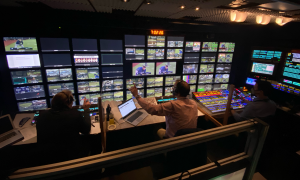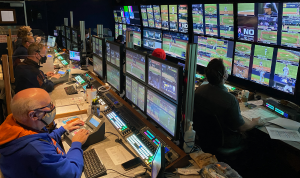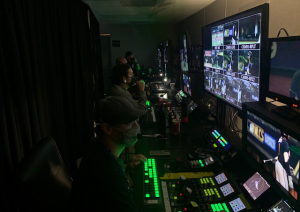World Series Preview: Fox Sports Expands Compound, Bolsters Camera Arsenal
Neutral-site Fall Classic poses unique challenges, offers some advantages
Story Highlights
In the 150+-year history of baseball, there has never been a World Series quite like the one set to begin tonight (7 p.m. ET, Fox), with the Los Angeles Dodgers battling the Tampa Bay Rays. And Fox Sports, in its 23rd year delivering the Fall Classic to U.S. homes, is prepared to meet the challenge with a sizable onsite operation.
Approximately 215 Fox Sports personnel are onsite at Globe Life Field in Arlington, TX, to produce this unique World Series, which will take place entirely at Globe Life Field in Arlington, TX. No travel days. No stadium strikes. One crew in one spot for the whole Fall Classic.

The World Series begins tonight on Fox, with producer Pete Macheska (left) and director Matt Gangl (center) calling the shots from Globe Life Field in Arlington, TX.
As a result, Fox has gone all-in on a single compound that is impressive in both size and scope. In a year full of hybrid and fully remote productions across the sports-television industry this COVID-ravaged year, this show feels very much like a throwback to the big onsite presence typical for a championship-Fox broadcast.
“We’ve built ourselves what feels like a U.S. Open or a Super Bowl setup,” says Brad Cheney, VP, field operations and engineering, Fox Sports. “There really is a very big world here that’s interconnected and acting as one big transport mechanism to get these broadcasts on the air.”
Empty Lower Bowl Offers New Camera Opportunities
Although upwards of 11,000 ticketed fans are being allowed in the stadium for each game of the World Series (as was the case with the NLCS), none of them are allowed in the lower bowl in the sections closest to the playing field. That has allowed Fox Sports to try some new things in their camera map.
According to Cheney, the broadcast’s midrange super-slow-motion cameras, for example, are located a lot lower than they normally would be and are, in his opinion, at a better angle. The crew has also added two low cameras (Sony HDC-4800’s running at 16X), which in a full stadium would need to be positioned on the outer ring of the lower bowl behind fans. The circumstances have also allowed the operations crew to raise them higher on platforms than normal.

Fox has more than 200 crew members onsite to produce this year’s World Series. Game Creek Video’s Yogi A and B units anchor the compound inside Globe Life Field.
“We’ve been able to add a bunch of little things and get the angles right,” Cheney explains. “That has been the beauty about being somewhere so long and being somewhere where the lowest part of the bowl is without fans. We’ve been able to line a lot more cameras up to get more-consistent, level shots of torso to head. That has been really important, I think, for changing the look of the broadcast with each game.”
All in all, the camera plan features 49 cameras, 19 of them high-speed. Canon is supplying all the lenses across the camera lineup, including the new CJ20 on a variety of handhelds and two DIGISUPER 122’s for the standard television replays and the Cine-Servo 50-1000mm and EF 300mm f2/.8 for the super-slo-mo replays.
Also included in the camera lineup are four capable of shooting with integrated augmented reality and a pair of two-point–cabled aerial systems: a low one running along the third-base line and a high one along the first-base line. Fox Sports tested a similar system last year at Yankee Stadium during the ALCS, and ROOT Sports Northwest set up a similar rig during its coverage of Seattle Mariners games during this regular season.
“They’ve looked spectacular so far,” says Cheney. “We’ve got some great shots with them, and I think, every night, you’re going to see more and more of it as both operators get into the flow and we start to see things. The nice part about being in a domed building is that you have a lot more structure to play with.”
On the audio front, 28 microphones are positioned around the inside of the stadium, including 14 buried in the infield dirt.
Cheney also notes that the crew has benefited from the use of new RF 4K video transmitters supplied by CP Communications, pointing out that it aided a leap forward in image quality and helped minimize the differences in appearance between wired and a wireless cameras.
Double-Barreled Compound Meets Resourcing, Distancing Needs
Committing to a full onsite operation certainly came with advantages and challenges for Fox Sports Director, Field Operations, Francisco Contreras and Manager, Remote Operations, Amy Burns. With the help of Technical Producers Sid Drexler and Tom Lynch, as well as Game Creek Video engineer Robert Kupillas, Fox has established a bubble-like compound capable of meeting all the needs of the crew of 200+ staffers while spreading things out in a safe and efficient way.

In addition to the traditional compound at Globe Life Field, Fox has built a secondary compound to allow social distancing. The trailers will house graphics, replay, video, and robotic-camera–support personnel throughout the series.
The traditional TV compound in the bowels of Globe Life Field houses Game Creek Video’s Yogi A and B units, where the primary above-the-line production personnel — such as producer Pete Macheska and director Matt Gangl — will work. Edit 4 and B2 have also been supplied to have provide some extra space in the compound.
Upstairs and outside the stadium, Fox has set up a secondary compound made up of office trailers housing graphics, replay, video shading, and robotics. These trailers support 140 channels of record, 28 channels of playback, four graphics machines, shading stations, positions for 4DREPLAY technicians, support trailers for operations and engineering personnel, and more.
Cheney offers a tip of the cap to NEP Broadcasting Engineering Manager Nick Romano for his team’s support in building out the secondary compound.
Meanwhile, CAT Entertainment Services is powering both compounds with UPS power for mobile units, auxiliary gear, and the rest of the technical workspaces. Peak Uplink and DTAGS (recently acquired by LTN Global Communications) are providing transmission services, and Lumen (formerly Century Link) and AT&T are supplying video and data services.
Thumbwar is providing both onsite and offsite editing and color solutions with staff both onsite and working remotely across the country.
As if pulling all of this together wasn’t challenging enough, Cheney acknowledges that the ultra-busy sports calendar that has resulted from schedules shifted by the COVID-19 pandemic made obtaining necessary resources difficult. With football (both pro and college in full swing) and the NBA, WNBA, and NHL bubbles recently completed, extra work by the operations team was needed to find an attainable balance of needs in Arlington for both the NLCs and the World Series.
“It’s a big change on what we’re used to doing,” says Cheney. “You look at the project and what we needed to do, and you started to realize that the normal gear that we need to pull off an event like this wasn’t necessarily fully available. There was a lot of logistics in the pieces of equipment. To get what we knew we needed, we had to take a different approach and figure out how to find a safe way to put on these shows in this environment.”
Meeting the Storytelling Challenges From the Front Bench
On the creative front, Fox Sports has been taking a bit of a different approach from its regular-season efforts. With some fans in attendance at NLCS and World Series games in Arlington, the network hasn’t needed to deploy its virtual-fan technology. Those resources have instead been reallocated to design more augmented-reality graphics for the game broadcast.

In the overflow compound, video shaders work in an expanded office trailer designed to accommodate the needed gear.
Also, the presence of fans and a neutral-site feel from the crowd affects the work being done on the audio front by lead A1 Joe Carpenter. His team is working with MLB to establish a strong audio presence for the broadcast — one that the team hopes will help the audience better appreciate who the home team is for each game.
The lack of a dynamic home-field fan presence is a storytelling factor that Macheska and Gangl have put a lot of thought and effort into. The pair is working closely with the features team onsite to dig deeper into the stories of the Dodgers and Rays and the geographic regions they represent.
“When you’re in the same venue the whole time and, every couple of days, the home team changes but the building still looks the same, it has a much different feel,” says Cheney. “It doesn’t jump out at you as to who the home team is. It doesn’t jump out to you that the crowd is biased in any way. So there’s a lot more storytelling that they’re having to work on.”
In 25 years of baseball coverage, Fox Sports has built a tradition of focusing the show on the fans in attendance and the cities that support the teams. The production team will be far more limited in its ability to do that this year but is making an effort to bring drama to this neutral-site series.
“It’s on us to tell more of a story about the game itself,” says Cheney. “That’s what we’ve been working on really deeply: how to analyze the game or provide people insight that they normally wouldn’t get.”
The World Series on Fox begins tonight at 7 p.m. ET.
